
|
A Start | B Intro | C Staff functions | D Waiter function | E Word lists | Dr Klaus Bung © 1973 and 2010 Klaus Bung Klaus Bung:
|
||||||||||||||||||||||||||||||||||||||||||||||||||||||||||||||||||||||||||||||||||||||||||||||||||||||||||||||||||||||||||||||||||||||||||
| 0 | Start of linguistic procedure |
| 1 | Refusing to receive guests |
| 2 | Receiving guests |
| 3 | Guests demanding waiter's attention (complaint) |
| 4 | Exploring guests' general wishes |
| 5 | Suggesting dishes |
| 6 | Explaining what a dish is and how it is made |
| 7 | Understanding the order |
| 8 | Communicating the order to kitchen staff |
| 9 | Guests complaining about delays in service |
| 10 | Bringing the food and ascertaining who has ordered what |
| 11 | Serving the food |
| 12 | Guests complaining about quality of food |
| 13 | Polite enquiry about quality of food |
| 14 | Guests complaining about quality of food (14 tends to exclude 12, and vice versa) |
| 15 | Bringing the bill |
| 16 | Justifying charges if queried |
| 17 | Taking money, giving change |
| 18 | Seeing guests out of the restaurant |
| 19 | End of waiter function |
The temporal order in which these operations may occur can be represented by a directed graph (Figure 19).
-------------------------------------------- page 56 -------------------------------------------
Figure 19: Central waiter function: temporal sequence of operations
( ' a ---> b ' = ' b may follow a '; key to numbers: Figure 18)
Even larger version of diagram
-------------------------------------------- page 57 -------------------------------------------
Figure 20: Matrix of Figure 19 (Key to numbers: Figure 18)
Click on image to make it larger.
-------------------------------------------- page 58 -------------------------------------------
An arrow emerging from a vertex, ' a ', of the graph and leading to another vertex, ' b ', in Figure 19 shows that the ordered pair (b,a) is in the 'temporal may-follow-directly relation', i.e. that ' b ' may follow ' a ' directly in time.
When following the arrows, never cross an arrow-head against the direction it indicates.
When two lines cross, you may never move from one line to another (i.e. change direction) except where the crossing lines merge in a small circle. Lines which cross each other without a circle are to be regarded as disconnected.
In cases of doubt, consult the equivalent matrix (Figure 20), which is unambiguous. Each cell, mij, of the matrix assumes the value 1 if j may follow i directly; otherwise mij = 0 .
Note that the matrix representation of the 'may-follow relation' is more convenient for the systematic examination of entries than is the graph representation. The 1-cells (cells with the value 1) below the diagonal of the matrix represent 'back-loops', i.e. occasions where an operation or a string of operations may be repeated or an operation that has been previously omitted may be carried out.
The 'may follow directly' relation is not transitive, i.e. a ---> b AND b ---> c do not imply that a ---> c !
Figure 19 shows that the waiter's operations can be divided into three stages:
(S) is the most important of these stages. Within (S), operation 7 is the one and only indispensible linguistic operation and 11 the one and only indispensible non-verbal operation. As a result of extreme abstraction, (S) may be reduced to operations 7 and 11. In terms of the medium-conversion model (Bung 1973), these two operations jointly would be represented by a vector from Groups 13 to 16 ('target
-------------------------------------------- page 59 -------------------------------------------
language into non-verbal event').
We can make more delicate subdivisions of the string of operations (Figure 19) and see how closely certain successive operations are connected by making an immediate-constituent analysis, using the bracketing diagram of Robins 1964, p 232. Figure 21 shows such an analysis. It also links two discontinuous constituents, namely (1, 2) with 18 and shows, for purposes of comparison, the earlier analysis into three constituents, 'receive' (R), 'serve' (S) and 'dispatch' (D).
Figure 21: Immediate-constituent analysis of waiter's operations
(Key to numbers: Figure 18)
-------------------------------------------- page 60 -------------------------------------------
We shall later concentrate our attention on operation 7. To start with, however, some initial observations will be made about various aspects of all operations in Figure 19 to indicate how a more comprehensive study of the foreign language needs of a waiter with associated functions might be approached.
Op 1: The waiter explains that the restaurant is closed / closed until /... This may put the guests off for good (go to 19). Or they will continue arguing until (Note 3), or come back when, the restaurant is open; in the former case Op 2 starts, in the latter case Op 2, 3 or 4 starts, depending on whether they are seen entering and depending on the customs of the restaurant. Both 1 and 2 may be omitted.
Op 4: This operation is always present, at least in rudimentary form: non-verbally if the waiter brings a menu, verbally if he asks 'What would you like to have? Can I help you? &c'. Op 4 is non-rudimentary if the waiter asks 'diagnostic' questions to ascertain the tastes of his guests. Op 5 and 6 can be omitted. Generally the situation, and not the waiter, determines whether an operation can be omitted.
Op 7: Orders may be for food, drinks, tobacco and utensils. If utensils have to be specifically requested, this is either necessitated by an idiosyncrasy of the guest (in which case the request follows Op 6 or 4) or it is due to the waiter's negligence or idiosyncrasies of the restaurant (in which case the request is more likely to follow Op 10 or 11). Eating utensils are not included in van Ek's list (1972). Either the waiter or the guest at threshold level (Trim 1971) should at least know the word for 'spoon' (knife and fork are no substitutes when a soup is to be eaten). Op 7 is basically receptive. But, as with all receptive skills, the waiter may be confronted with language he does not know or he may not hear clearly what has been said. Therefore, it is an advantage for him if he has also the productive skill of inducing the guests either to repeat
-------------------------------------------- page 61 -------------------------------------------
their order ('What did you say?'; see Kleist's example, my Note 3) or to explain what 'kind of food' they have ordered.
Op 8: In the present study we take this skill for granted. In the linguistic settings under discussion, the kitchen staff either have the same native language as the waiter, or, if one or several of them have not, they are foreigners in the country of the hotel and their problem belongs into a case study of the linguistic problems of kitchen staff, not of waiters. On the other hand, in the linguistic setting of Richterich's waiter study (1972, p 46), Op 8 would need specific consideration - as Richterich indicates through his specification '3.1.2 Colleague / colleague' (p 46). This is an example to show that different linguistic settings can demand different task analyses. Richterich's specification of the linguistic setting ('Italian-speaking waiter. French in a French-speaking country.') is precise but too narrow. Op 8 would become prominent in a huge number of different linguistic settings as well. The MOT-model, sketched out above, provides an instrument for making such specifications with generality, precision and brevity.
Op 10: This operation always takes place but can assume very rudimentary or even trivial forms. It is trivial if there is only one guest at the table (Richterich's case A, 3.3.3, on p 46), it is non-verbal when the waiter remembers which member of a group of guests has ordered what. Otherwise a very simple question can establish 'Who ordered the chicken?' &c. Op 11 is non-verbal.
Op 13 may be omitted. The waiter cannot be brought into a situation (except by his employer) in which he has to make such an enquiry. In the simplest case, one question (e.g. 'Is the food all right?' - 'Do you like the food?') suffices. At a more advanced stage (but still below T-level), the waiter should be able to chat on a little or have some more alternative questions available. The fact that this operation cannot be forced onto the waiter distinguishes it from other optional operations. All of them can be forced onto the waiter and if he cannot respond to them verbally, he will have to do so through non-verbal actions (henceforth referred to as 'gestures', i.e. even bringing the food is called a 'gesture'). If he can respond neither
-------------------------------------------- page 62 -------------------------------------------
through words nor through gestures, difficulties will arise.
Op 15: This will be done at the request of the guests or when the waiter goes off duty. Op 17 may in some restaurants be carried out by a cashier at the exit. A few polite phrases suffice for Op 18.
We now investigate who triggers off the individual operations (see tabulation in Figure 22).
Op 1: Triggered off by guest, by appearing inside or outside restaurant (gesture) or making appropriate remarks (words), all at the wrong time of day, or in the wrong type of clothing, or with the wrong blood-alcohol level, &c.
Op 2: Similarly triggered off by the guests, at the right time and in the right state, or following unavoidably from Op 1.
Op 4: Can be triggered off by Op 2, 3, 9-14, but seldom by Op 1, which will usually be followed by a time-lapse of over a minute (Note 4).
Op 10: This is the only operation triggered off by the kitchen staff.
Op 15: Triggered off by the guests when they ask for the bill or by the waiter when he goes off duty or the restaurant is to be closed.
Op 17: Initiated by the guests by putting their money on the table, on a plate or by giving it to the waiter.
Op 18: Initiated by the guests when they leave or by the waiter when he asks the guests to leave or makes them feel uncomfortable.
Figure 22 describes each operation by a vector of four components. We can partition the set of all operations into seven subsets (classes of operation), each of which corresponds to a distinct vector. The classes are also listed in Figure 22, in the column
-------------------------------------------- page 63 -------------------------------------------
marked 'vector name'.
Figure 22: Trigger tabulation (Key to operations: Figure 18)
| Abbreviations: | |
| w waiter | p preceding operation |
| g guest | SC sum of components |
| k kitchen staff | UT identity of unique trigger |
The classes differ in size. Figure 23 lists the classes in order of size from largest to smallest:
-------------------------------------------- page 64 -------------------------------------------
Figure 23: Frequency of vectors in Figure 22
| Vector name | Number of instances |
| ----------------------- | ------------------------------ |
| 3 | 10 |
| 1 | 2 |
| 6 | 2 |
| 2 | 1 |
| 4 | 1 |
| 5 | 1 |
| 7 | 1 |
| ----- 18 total ====== |
|
Operation 7, on which we shall later concentrate our attention, belongs to class 3, the largest, and is thus a typical example in respect of the triggering mechanism.
One might choose different ways of partitioning the set of all operations, e.g. on the basis of Figure 22 into those vectors the sum of whose components is 1 versus the rest. The former represent operations whose requirements are easier to predict (in respect of the trigger) than those of the others. These vectors are marked 1 in the column SC (sum of components) in Figure 22. They are in the majority. They in turn can be classified according to the identity of their unique trigger. This classification is shown in column UT (unique trigger) of Figure 22. It is seen that the waiter is the unique trigger for one operation only, a comparatively trivial one.
The trigger-vectors (i.e. those listed in Figure 22), henceforth referred to by their vector names (V1, V2, ...), are associated with sets of operations which have specific properties.
-------------------------------------------- page 65 -------------------------------------------
V5-operations have the following properties:
They demand at least one productive skill from the waiter.
Figure 22 contains only one operation of this type, Op 13, but future analyses may yield further V5-operations.
V3-operations have the following properties:
They demand both receptive and productive skills from the waiter. (Whenever a guest gives a waiter something to understand, he expects some verbal or non-verbal action to follow.)
V6-operations have the following property:
It is not possible to predict with absolute certainty whether they will follow the pattern of V5 or of V3. The waiter therefore has to be prepared for the worst. However, such predictions can be made for some more narrowly defined types of hotel / restaurant and for specific establishments. Moreover, for smaller and larger classes of establishment, probabilities of V5 and V3 can be established. The importance of acquiring certain skills and the associated target standard for each skill can accordingly be computed. (Note 5)
V1, V4 and V7 operations have the following properties:
-------------------------------------------- page 66 -------------------------------------------
V2-operations do not concern us here because we assume that kitchen staff and waiter speak the same native language.
All operations can be triggered off and carried out by non-verbal means (i.e. without either the waiter or the guest using a foreign language). For instance, Op 1 and Op 2 can be performed by brute force or other gestures. Flowcharts with hierarchies of food descriptions (hot / cold, liquid / solid, sweet / piquant; meat-based, egg-based, rice-based, flour-based; &c) can be used for Op 4 and 5. Explanatory leaflets or translated menus can be used for Op 6. (I call this a non-verbal operation because handing over a leaflet, regardless of what it contains, is a motor-skill, not a verbal skill). The order (Op 7) can be given by pointing at the translated menu or by writing down numbers referring to it. Op 8 can be handled in the same way. &c
The fact that set leaflets and translated menus can be used so effectively is due to the fact that the *** essential *** utterances can be reduced to an equivalent finite set of utterances ('phrase-book' nature of the skill). For this very reason foreigners survive even in the present pre-unit/credit age and without sharing a language with the waiter. It has yet to be demonstrated that learning of phrase-book skill is worthwhile (e.g. in the sense of Frank and Frank-Böhringer 1968) for waiters, that small employers are willing to pay more for waiters who have such a limited skill or will employ them by preference. By 'learning' I mean here deliberate learning, with a conscious investment of time and, perhaps, money, as opposed to incidental learning, which is very common among waiters.
-------------------------------------------- page 67 -------------------------------------------
All operations (except 11, which is essentially non-verbal) can be carried out by very limited linguistic means or by a range of less restricted linguistic means.
My query about the worthwhileness of learning concerns only the very restricted skills if tackled as an end in themselves (NB: The query does not decide the question one way or the other!). This limited end is often achieved by:
On the other hand, there is no doubt that greater linguistic competence (even below T-level) can be a great asset, facilitate and speed up operations, charm or flatter the guests and be of positive commercial value to the restaurant - and thus worth paying for. Our analysis of the more limited skills is worthwhile inasfar as it shows useful stepping stones towards greater mastery.
We now have to search for methods which determine in which order the various linguistic skills corresponding to the waiter's operations can, or should, be learnt.
A number of independent criteria offer themselves for consideration, e.g.
-------------------------------------------- page 68 -------------------------------------------
We shall consider each of these criteria in turn and, where possible, design partial orders of operations, each based on a different criterion.
If the partial orders of task size, importance and 'logical support' are valid, the task of determining a simple order for the acquisition of the part-skills can be delegated to a computer. It is possible to design an algorithm which constructs a simple order that has the following properties:
Deviation can be measured by the number of priority elements in the partial order which have been 'overstepped'.
Which of these principles (and which additional principles) or constraints should govern the construction of such an algorithm is a fundamental question for all similarly utilitarian studies but constitutes a problem whose solution goes beyond the limits of this particular study.
The estimates of size are coarse and intuitive. They may well have to be changed once all operations have been analysed in detail. Only the linguistic aspects of each operation have been considered; therefore Op 11 ('Serving the food') has been represented as the easiest (smallest) task, namely a task of zero-size, since no verbal skill is involved at all.
-------------------------------------------- page 69 -------------------------------------------
Since the verbal aspect of each operation can be varied (from very primitive phrase-book approach to full T-level competence as estimated by van Ek 1972 and Wilkins 1972), my estimate of task size has been based on the assumption of full T-level competence. In other words: How large is the amount of knowledge (skilled behaviour) or how large is the subset of rules from those proposed by van Ek and Wilkins that could be useful in each operation whose task size is estimated.
Notation: In Figure 24, the arrows connecting the numbers represent the 'is-smaller-than relation', i.e. 'a ---> b' means "each element of 'a' is smaller than each element of 'b' ", or "the largest element of 'a' is smaller than the smallest element of 'b' ".
Partial orders of a certain structure are difficult to represent as graphs if they contain a large number of elements. The peculiar structure of Figure 24 itself is the result of an attempt to reduce the confusion that would result if every pair (a,b) in the is-smaller-than relation had been assigned its own arrow. It must therefore be pointed out, for the benefit of future studies of this nature, that all relations (and hence all partial orders) can be represented as matrices as well as as graphs (see Harary et al 1965). The cells mij of the matrix assume the value 1 if the ordered pair (i,j) is in the relation, i.e. if, in the graph of the relation, an arrow goes from i to j. Otherwise the cells assume the value 0. This possibility of converting graphs into matrices (and vice versa) means that relations (and hence partial orders) of any size and degree of complexity can be represented and handled.
The matrix corresponding to Figure 24 is shown in Figure 25.
-------------------------------------------- page 70 -------------------------------------------
Figure 24: Graph representing partial order of task size
(a ---> b means "each element of 'a' is smaller than each element of 'b' ". Key to numbers: Figure 18)
-------------------------------------------- page 71 -------------------------------------------
Figure 25: Matrix representing partial order of task size
(Cell mij = 1 if 'i' is smaller than 'j'; otherwise mij = 0.
Key to operations: Figure 18)
-------------------------------------------- page 72 -------------------------------------------
Figure 26 shows the graph of the 'is more important than' relation. "a ---> b" means " 'a' is more important than 'b' ". Again the relation set up here is based on a coarse intuitive estimate and may have to be changed after more thorough consideration. I am trying to exhibit a methodological principle rather than give finished results.
The various participants in the operations under discussion will attach different degrees of importance to any given operation (cf Ehlich and Rehbein 1973, p 219 ff). The hotel owner will be primarily interested in Op 17, which enables him to get his money. The waiter's primary interest may well be
Of these transactions, (1) is not included in the set of operations under discussion because, in our linguistic setting, the waiter and the hotel-owner are presumed to have the same native language. In a linguistic setting of type 40 or 42 (like that considered by Richterich 1972) (for notation, see my Figure 1 and subsequent explanations), the payment, checking and acceptance of wages and its linguistic requirements will have to be specifically considered (Note 6).
The guest's primary interest is in getting his food. This is realised in Op 11. His secondary interests (Ehlich and Rehbein 1973) have not been considered in this study. They are either provided for in the permanent set-up of the restaurant and do not have linguistic implications or, when they have, they will be well above the level of competence which this study is concerned with.
As will be shown in the 'operational must-precede graph', Figure 27, Op 17, the owner's primary interest, cannot take place unless the guest's interest (Op 11) has previously been satisfied (even if only pro forma). The waiter's interest in getting a tip is incorporated in Op 17, thus closely linked with the owner's primary interest and equally dependent on the (satisfactory?) transaction of Op 11. The waiter's interest in getting his wages might be satisfied for a few weeks, even if there were no guests to serve, but sooner or later he (//sentence continued on page 74)
-------------------------------------------- page 73 -------------------------------------------
Figure 26: Graph representing partial order of importance
('a ---> b' means "each element of 'a' is more important than each element of 'b' ". Key to numbers: Figure 18)
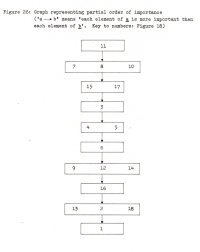
-------------------------------------------- page 74 -------------------------------------------
would find himself without a place of work.
It is therefore not arbitrary if we specify the partial order of importance of the waiter's operations from the *** guest's *** point of view.
There are situations when a learner has acquired a number of skills which occur in the task analysis but which he cannot apply because he still lacks one or more skills which are essential for the performance in his job. Thus, in performance terms, it might appear that he knows nothing about an operation whereas in fact he may know a great deal. Assume, for instance, a technical translator who wishes to translate from the target language into his mother tongue and who knows the technical vocabulary and the technical subject matter in the target language but not in his mother tongue. He would fail any translation test abysmally, even though he has already acquired most of the skills necessary for his job (see Gilbert 1969, p 12, and 1967 for other examples). The translator has what Gilbert calls a 'performance deficiency'. Any skills which could remedy this performance deficiency should have a high priority in the order of learning. The result will be increased motivation because the learner can immediately (or very soon) reap the reward of his efforts in performance terms. (Consider the case of a person who has all the attributes and qualifications of a TV announcer but suffers from a slight stammer, a performance deficiency.) This leads to Gilbert's technique of 'back-chaining' (Gilbert 1969, p 29-38, and Lamérand 1969, p 72). It asserts that operations should not be learnt in the order in which they occur in the 'operational must-precede relation' (see Figure 27) but in the reverse order - while someone else (e.g. the instructor, the teaching programme, another employee, &c) carries out the operationally essential preceding operations. This will give the learner the satisfaction of always ending up with a completed job and with seeing (or knowing about) the fruits of his labour.
-------------------------------------------- page 75 -------------------------------------------
Back-chaining has another advantage in a situation where the learner tries to get by with the minimum amount of skill. It does not lead the guest to expect too much from the waiter. If the waiter received the guests (Op 2) with complex utterances spoken fluently and without a foreign accent, the guests would expect a similar performance when requesting an explanation about the preparation of some dish. But if the waiter learns the later (not necessarily the latest!) operations first, the guests will have true information about the nature of the waiter's competence and will try to adjust their linguistic behaviour accordingly.
The principle of back-chaining can, of course, override any logical subject matter analysis (of the type proposed in Bung 1969a) provided the lacking prior skill is compensated for by other people, as Gilbert proposes.
We shall now try to establish the 'operational must-precede relation'. It will show which operations are closely (perhaps inextricably) interconnected and which are the shortest operational chains which the learner could acquire with a prospect of Gilbertian 'job-satisfaction'.
This refers to operational precedence, not necessarily to the learning precedence. In the relation of operational precedence, if (i,j) is in the relation, then ' j ' cannot be carried out unless ' i ' has been carried out at some earlier point of time. However, it is not demanded here that ' i ' must have been carried out *** immediately *** before ' j '. The relation presented here is therefore the 'must precede directly or indirectly' relation.
As can be seen when comparing the matrices of the present 'must-precede' relation (Figure 28) and the 'may-follow' relation (Figure 20), the must-precede relation is a proper subset of the may-follow relation: all one-cells of the must-precede matrix have value 1 in the may-follow matrix, but not vice versa. It seems to me that there (// sentence continues on page 78)
-------------------------------------------- page 76 -------------------------------------------
Figure 27: The operational must-precede relation
('a ---> b' means " 'a' must precede ' b ' ".
Key to numbers: Figure 18)
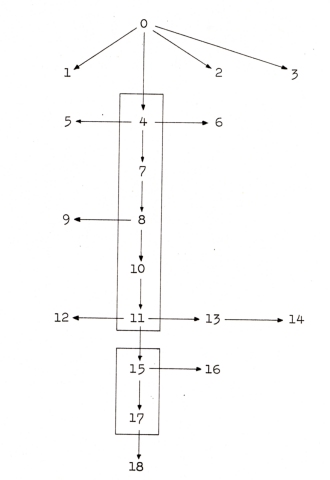
-------------------------------------------- page 77 -------------------------------------------
Figure 28: Matrix of the operational must-precede relation
(mij = 1 if ' i ' must precede ' j '; otherwise mij = 0.
Key to operations: Figure 18)
-------------------------------------------- page 78 -------------------------------------------
are formal rules by means of which the must-precede matrix can be derived from the may-follow matrix, and it should therefore be possible to design an algorithm which carries out this transformation. This would enable a computer to help in future analyses of this kind.(Note 7)
The must-precede relation of Figure 28 shares certain semantic and formal properties with the Delta-diagram (Bung 1967, ch 6, and 1971) but differs by specifying an order of operations which are the *** result *** of learning and not by specifying the order of learning.
We now turn to the 'logical support' relation. This determines whether, for any pair (a,b) of rules or skills, mastery of 'a' is a prerequisite for the execution of 'b'. This kind of relation (which often turns out to be a partial order and not a simple order) has been used in connection with specific, non-linguistic, subject matters by Lánský (Lansky), Weltner and others (references in Frank and Meder 1971, p 61 f), by Wyant 1971, 1972 and 1973, and by Kingsley et al 1971. In the field of applied linguistics it has lead to the construction of various versions of the Delta-Diagram (Bung 1967, ch 6, 1970, 1971 (with revised interpretation), 1974).
The Delta-Diagram (Figure 29) will not be discussed in detail here. Suffice it to say that it shows the logical support relation among major blocks of skills / rules for an idealised pair of target language and native language. Notation: 'a ---> b' means "at least one element of 'a' must have been learnt before the first element of 'b' is tackled and all elements of 'a' must have been learnt before the last element of 'b' is tackled' (Bung 1971).
In the analysis that follows, we shall concentrate on the waiter's needs for vocabulary and phrase learning, i.e. on a more detailed analysis of Section 5 of the Delta(2)-Diagram. As the diagram shows, this presupposes that the waiter has done at least some sound-discrimination (//sentence continues on page 80)
-------------------------------------------- page 79 -------------------------------------------
Figure 29: The Delta-Diagram: Communication skills
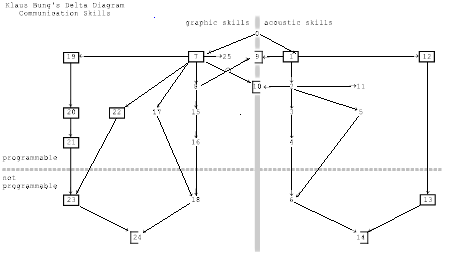
Click here for larger versions: Delta-Diagram with key
0 Start 1 Ear training 2 Oral mimicry 3 Elliptic sentences 4 Sentence structures and chains 5 Vocabulary and idioms 6 Unaided speaking 7 Recognising written symbols 8 Copying written symbols 9 Dictation * 10 Reading out aloud * 11 Paired associate learning of 12 Aided auditory comprehension 13 Unaided auditory comprehension |
14 Conversation 15 Writing grammatical sentences 16 Consulting a reference grammar 17 Consulting a dictionary for writing in the foreign language 18 Unaided writing 19 Principles of systematic guessing 20 Reading comprehension 21 Consulting a reference grammar 22 Consulting a dictionary for reading in the foreign language 23 Unaided reading 24 Correspondence 25 Understanding grammar (without direct relation to the acquisition of specific speaking or writing skills) |
* These are conversion rather than communication skills. |
Receptive and partly receptive skills are presented in closed and open boxes respectively. The remaining skills are productive. |
-------------------------------------------- page 80 -------------------------------------------
discrimination and articulation training. How much of it he should have done is a question yet to be investigated; in part it depends on the conditions of noise in which he has to operate (cf discussion of telephonist and the problem of intelligibility in Section 3.225).
The operational must-precede relation (Figure 27) reveals that certain chains of operations are closely dependent on one another, namely 4, 7, 8, 10, 11, 15, 17. However, there is a 'semantic' boundary between 11 and 15, a point at which it is much more likely that another person takes over from the waiter than it is at any other point in the chain. We therefore establish two blocks of operations which are marked by the two rectangles superimposed onto Figure 27.
We have already established the extreme importance of Op 11 (see Figure 26) and shall now concentrate on the chain of operations of which Op 11 is a part.
By Gilbertian principles (back-chaining; Gilbert 1969, Lamérand 1969, p 72), Op 11 should be taught first, and this is in fact done in practice: no waiter would set out to learn foreign languages (for the explicit purpose of helping him in his job) if he had not first begun to learn how-to serve food. Kleist's waiter (Note 3) accompanies Op 11 by talk ('Da.') but this does not seem to be common among English-speaking waiters. We therefore treat Op 11 as non-verbal. Because of our chosen linguistic setting, Op 8 can also be omitted from consideration. It remains to analyse the vocabulary and fixed phrases of Op 4, 7 and 10. We confine ourselves to a very elementary level of competence (Figure 30).
It is in the nature of vocabulary and fixed phrases that they *** can *** be learnt in almost any order, and we shall therefore not set up a linguistic / pedagogical must-precede relation among the subject matter of Op 4, 7 and 10 (Figure 30).
-------------------------------------------- page 81 -------------------------------------------
Figure 30: Vocabulary categories for Op 4, 7 and 10
| Op 4 | |
| receptive | trigger word: waiter |
| productive | nouns: food, drink |
| adjectives: descriptive of food | |
| fixed phrases:
Can I help you?
What would you like? Would you like ...? |
|
| Op 7 | |
| receptive | trigger word: waiter |
| nouns: food, drink, tobacco, utensils | |
| adjectives | |
| numerals up to 20 | |
| productive | same as 'receptive', for confirmation |
| Op 10 | |
| productive | nouns: food, drink |
| fixed phrases: The ... was for you? | |
There are, however, certain sequences of learning which bring a quicker pay-off in operational terms and there are others which should definitely be discouraged ( *** if *** the language is being learnt for utilitarian purposes). On this basis we set up the must-precede relation of Figure 36.
The categories to be ordered in Figure 36 are listed in Figure 31.
As long as the list of adjectives has not yet been established (lack of time prevents me from proposing a list here), our remarks about the position of adjectives in the must-precede relation must be rather general and tentative. It is clear that adjectives can be learnt before nouns but that they cannot usefully function before at least some nouns have been learnt. This fact is reflected in Figure 36.
-------------------------------------------- page 82 -------------------------------------------
Figure 31: Vocabulary categories for Op 4, 7 and 10
| receptive | productive |
|
|
The trigger word, 'waiter', is of obvious, vital importance.
While I would prefer to have the generic food nouns learnt before the specific food nouns (if any), a waiter with a clear knowledge of the occurrence probabilities of specific food nouns in his particular hotel may prefer (and benefit more) from learning (some of) the specific food nouns first. Therefore Figure 36 does not establish any priority relation between generic and specific food nouns.
Animal nouns could also be learnt before food nouns but, like adjectives, they could not become useful before at least some generic food nouns ('meat') have been learnt. Further analysis will have to establish for each language, including English, whether the immediate pay-off is greater if the waiter learns generic food nouns plus animal nouns (e.g. 'meat of calf') instead of learning more specific food nouns (e.g. 'veal').
-------------------------------------------- page 83 -------------------------------------------
Tobacco nouns and utensil nouns are less important than food nouns and should therefore, in my preferred order, be learnt after the food nouns. This applies to tobacco nouns because selling tobacco products is not the central business of a restaurant and to the utensil nouns because the waiter can largely avoid such queries by serving the guests with the right utensils to start with. However, I feel that my grounds for establishing priorities are not weighty enough for depriving the waiter of his freedom to choose his own sequence. Hence no priority has been established between food nouns on the one hand and tobacco and utensil nouns on the other.
The waiter should be able to make do with the numbers up to 20; we assume that he will usually serve parties of less than 20. If there are more than twenty guests ordering jointly he will usually find it easy to extend his number system to 30 by using his creative common sense (Note 8).
I have not brought any verbs, prepositions, &c, into the subject matter specification of Op 4, 7, 10 and 11. While they would be required of an articulate waiter at a higher level of competence (but still below T-level), they are much less important than the categories listed and, in the absence of a corpus of 'waiter utterances' (which should be procured), they are very difficult to establish in any reasonably objective fashion.
We now have to present the pedagogical must-precede relation among the subject matter elements of Figure 31 in a formal manner. Notational difficulties arise because the must-precede relation under discussion contains not only conjunctions but also alternatives. As a formal problem this is new in my own research on subject matter analysis and I have not come across any relevant ready-made notations in the fields of formal pedagogics or applied linguistics. The search for a solution is not an 'academic whim' but a practical necessity if our work is not to founder because of the lack of an efficient notation: fairly simple relations, like the one under
-------------------------------------------- page 84 -------------------------------------------
discussion can just about be described in the discursive manner we have used so far. But as soon as the subject matter becomes more complex,
We shall therefore propose a diagrammatic notation for the present problem. The Delta-Diagram (Figure 29), which is representative for many other subject matter analyses resulting in partial orders, contains simple precedence and conjunctions (i.e. two arrows emanating from x and y and leading to z mean 'x AND y must both precede z, i.e. z must not be tackled until both x AND y have been learnt). On the other hand, the graph of the may-follow relation (Figure 19) or the graph of a Crowder teaching programme (branching programme; e.g. Crowder 1962) contains simple precedence and alternatives (i.e. two arrows emanating from x and y and leading to z mean 'x OR y must precede z', i.e. z must not be tackled until at least one of x or y has been executed). The simple precedence in a may-follow relation (i.e. when only one arrow enters z and this arrow comes from, say, y) apparently enters the must-precede relation corresponding to the may-follow relation.
Our problem consists in devising a diagram that represents a must-precede relation which contains both conjunctions and alternatives. A solution can be sought in the fields of circuit algebra (personal suggestion from Kenneth Rouse, University of London Goldsmiths' College) or the theory of neuron nets.
I have not tried to investigate the notational problems of CA-relations (i.e. relations containing conjunctions and alternatives) in detail but have devised a notation which, at least, satisfies the present problem and can serve as a basis for further discussion and research.
-------------------------------------------- page 85 -------------------------------------------
The notation is adapted from that of neuron nets in Segeth 1966, p 96. Segeth represents a conjunctive net as follows:
Figure 32: Conjunction
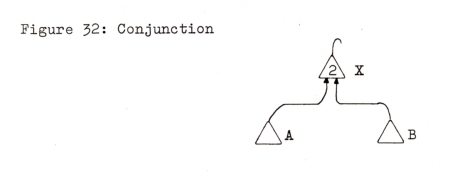
This means: Neuron X does not fire unless at least two preceding neurons have fired in the previous time instant. In our terms: Both A and B must precede X.
Segeth represents an alternative net as follows:
Figure 33: Alternative
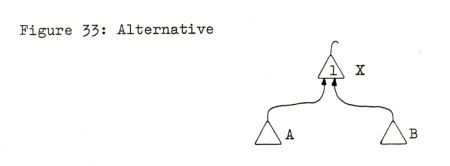
This means: Neuron X does not fire unless at least one preceding neuron has fired in the previous time instant. In our terms: Either A or B must precede X.
The number of neurons that must fire before X can fire is written into the triangle that represents X. The name of the neuron is written beside the triangle.
We need a notation that can easily be typed and minimises the labour of drawing (curves, boxes, &c). We therefore abolish the triangles
-------------------------------------------- page 86 -------------------------------------------
and write the quantity of prior neurons that must have fired as a raised index to the right of the name of the neuron under consideration. Thus we write the conjunctive and alternative nets of Figures 32 and 33 as follows:
Figure 34: Conjunction and alternative in new notation
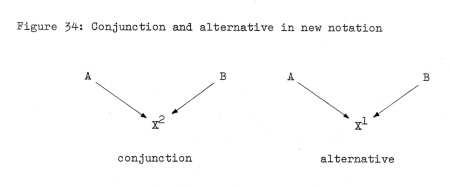
Imagine now a CA-relation of the must-precede type. The priorities to be represented in a graph (Figure 35) are the following:
| 1 ---> 2 | 1 must precede 2 |
| 2 or 3 must precede 4 | |
| 3 ---> 5 | i.e. 3 and 6 must precede 5 |
| 6 ---> 5 | |
| 1 ---> 6 | 1 must precede 6 |
Figure 35: Graph containing conjunction, alternative and simple precedence (The numbers are arbitrary and do not refer to any operations.)
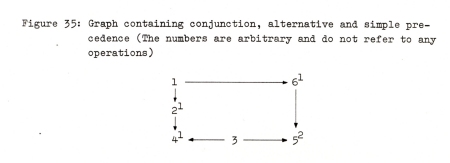
-------------------------------------------- page 87 -------------------------------------------
Figure 36: Pedagogical must-precede relation of skills listed in Figure 31
('0' means 'Begin')
-------------------------------------------- page 88 -------------------------------------------
An effective method of representing CA-relations in tabular or matrix form has yet to be found.
We can now represent the must-precede relation of the subject matter elements listed in Figure 31. All SM-elements represent only spoken language. Receptive and productive skills are differentiated by different numbers in Figure 31. To make them stand out clearly in Figure 36, we have, in addition, placed each receptive skill inside a circle. To avoid a proliferation of arrows, several arrows or their parts have often been superimposed on another. The interpretation of the diagram should, however, be clear provided the reader does not cross arrow-heads against the direction of the arrow-heads.
-------------------------------------------- page 89 -------------------------------------------